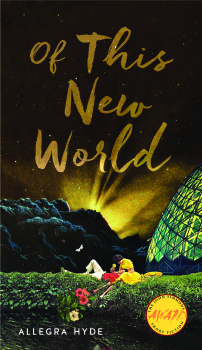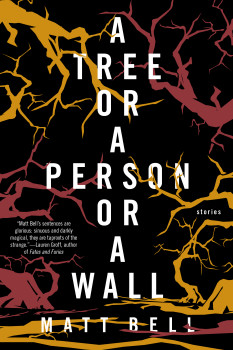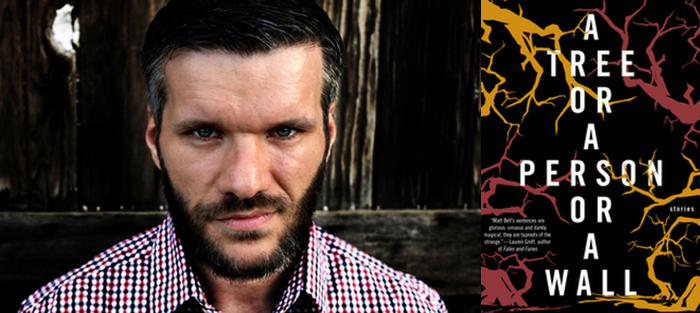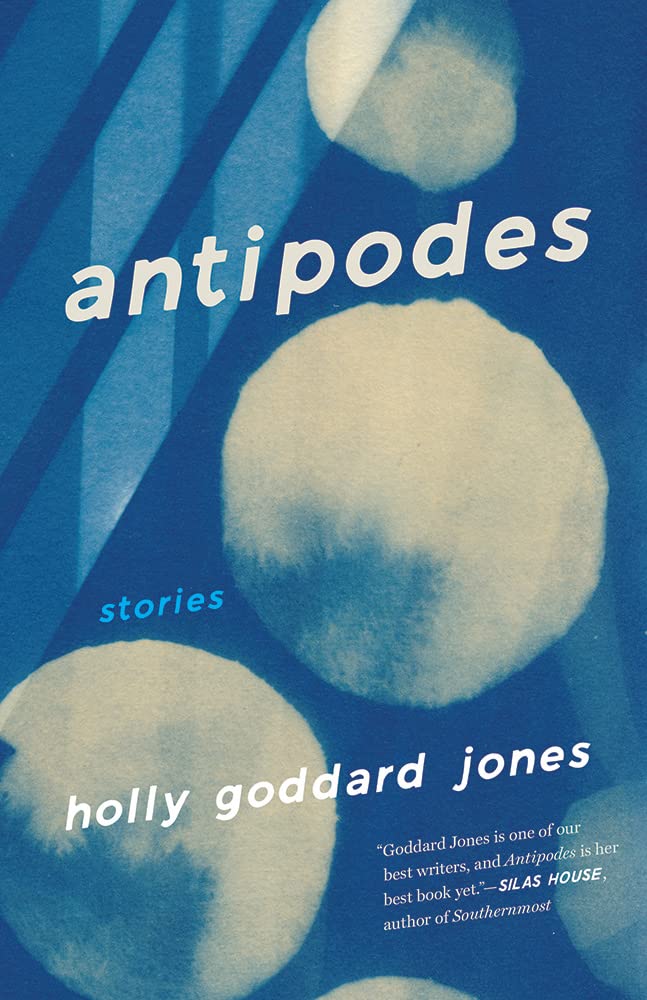The title story in Matt Bell’s new collection, A Tree or a Person or a Wall (Soho Press), places readers in a locked room with a screeching ape, a confused child, and an atmosphere of complete powerlessness. It’s a story notable for both its originality and its ability to unsettle. These qualities infuse the collection as a whole, as Bell moves seamlessly between tales of kidnappings, retellings of fairytales, and even historical fiction. A Tree or a Person or a Wall manages to evoke both the imaginative playfulness of Karen Russell and the lyrical horror of Cormac McCarthy. With material written over a span of ten years, the collection is fearless in its willingness to probe the darker side of human existence, and to do so with inventive finesse.
I first met Bell when he joined the faculty at Arizona State University, where I was finishing my MFA in Creative Writing. Now, a couple years later, he’s publishing his seventh book and I’m publishing my first, a collection of stories called Of This New World (University of Iowa Press). We decided to talk about our new books and writing processes over email.
Interview:
Allegra Hyde: A Tree or a Person or a Wall follows two recent novels, a book of nonfiction, a novella, an earlier story collection, and several chapbooks, among other publications. Is there a category of writer with which you identify most strongly? As in, are you a novelist who writes stories on the side? Or a short story writer at heart? Something else?
Matt Bell: I don’t know how much I think about defining that identity as I used to. I’ve definitely been spending most of my time recently working on novel-size projects, but the work itself is, for most of the process, done at a completely different scale. A day’s work is a good handful of pages, and it doesn’t feel particularly different to be writing a scene in a novel versus one for a story. It’s only later in the process that the work takes dramatically different skills, in assembling and structuring the whole. (And of course revising a novel is its own beast.)
Mostly, I think I’m just happy to have a life where I get to spend a lot of time being creative and making things, whether that as a writer or in some other part of my life. I think for a long time I was invested almost entirely in the idea of becoming a “writer”—and now I’m just as interested in what else I might be able to become.
Before you moved away from Tempe, you were working on a first novel, which I hope is still going well. Does it feel like cultivating a separate identity to you, becoming a novelist vs. being a story writer?
 They do feel like two separate identities to me. Having written and published short fiction, my story writer identity is more confident. She thinks she knows her way around the block. But writing my first novel feels like visiting a city I’ve never been. Sure I have some maps—in the form of other people’s novels—but they are maps to other cities. My novelist identity is essentially trying not to appear like a panicked tourist.
They do feel like two separate identities to me. Having written and published short fiction, my story writer identity is more confident. She thinks she knows her way around the block. But writing my first novel feels like visiting a city I’ve never been. Sure I have some maps—in the form of other people’s novels—but they are maps to other cities. My novelist identity is essentially trying not to appear like a panicked tourist.
Speaking of returning to familiar territory, A Tree or a Person or a Wall is an unusual collection—it includes stories and a novella, new work in addition to material from previously published books. What was your vision when putting it together?
In 2013, right before my first novel came out, my two previous books went out of print. Both had been published by very small independent presses—both essentially a single person—and for various reasons my books weren’t going to be available anymore. Soho Press, who was putting out my novel, immediately began talking to me about republishing the books, but rather than simply put them back out in the same form, we decided the best thing to do would be to wait until after I’d finished the novel I was writing then, so that I could write some more new stories and think about how best to put everything out. What we can up with became A Tree or a Person or a Wall: the stories I liked best from my collection How They Were Found (Keyhole Press, 2010), my novella Cataclysm Baby (Mud Luscious Press, 2012), and seven new stories, all arranged together as if they’d been meant to exist together from the beginning, rather than as some kind of selected stories. But that’s really more of a practical concern; the artistic part of the answer is that I wanted to find an arrangement that would create new arcs and through-lines through my stories. What arrangement would create the most tension, the most emotional or intellectual or moral resonance? It had to be different than the effect of the previous volumes, or else there wasn’t much reason to publish another one.
The way you describe story arranging, it almost sounds like building a kind of macro-fiction. By finding the arcs and through-lines in a series of many stories, you are creating one really long story—a collage-style narrative where disparate parts take on new meaning depending on how they ordered, how they juxtapose one another. The challenge is then getting everything to read cohesively. Could you talk a little more about the editing process?
Even though a lot of the stories had been edited several times—at literary magazines when they were first published and by my previous publishers—my editor Mark Doten at Soho worked through the whole book with me again. It was great to have a fresh eye on these stories—some of them are ten years old—and also to return to them myself, having written two or three other books since writing some of them. The oldest stories largely stayed the same, but there are tweaks and cuts throughout. One interesting bit, perhaps noticeable only to me, is that I ever-so-slightly turned up the Midwestern setting in some of the stories. When I first wrote them, I think I was avoiding being too specific about where they were set. But rereading them this year, after writing a novel set in Detroit and moving to Arizona, it was even more obvious to me that most of them had always been set in Michigan. Anytime my editor asked for an extra detail or for me to flesh something out, I almost always took that opportunity to expose some other part of the landscape, pulling the camera out just a little further to widen the frame.
You finished editing your first collection this year. Was there anything that surprised you about that process? An opportunity that appeared once the stories were arranged together, or some problem that needed to be addressed?
When I first started sending the manuscript out, it wasn’t ordered quite right. My goal had been to produce a collection composed of stories that all dealt with the utopian impulse, particularly in the Americas. Individually, the stories more or less did that. But as a whole, they still weren’t adding up to a larger narrative. Then I started to recognize this environmental thread. Many of the stories touch on the natural world—either its veneration or degradation—which fits closely with concepts of utopia. This gave me the idea to start the collection with “After the Beginning,” a retelling of Genesis, which embodies that foundational sense of severance from an environmental paradise. Once I had that story situated, all the others fell into place.
A binding factor in your collection also seems to be the presence of fairy tales or fairy tale techniques. For instance, characters are not always given names, but rather referred to as “the man” or “the younger sister.” A story like “Wolf Parts” offers an actual retelling of “Little Red Riding Hood.” What about the narrative possibilities of fairy tales seems especially powerful to you as a writer?
 My favorite aspect of fairy tales is their seeming inexhaustibility. Before writing “Wolf Parts,” I immersed myself in version after version of “Red Riding Hood,” eventually noting a handful of shared elements that appeared in almost every retelling, no matter which century or which country the version originated in. The fun of writing the story was trying to find as many ways as possible to shuffle those elements, changing them around, using them in different ways. I think I wrote about sixty of these micro-retellings, then cut back to the forty or so that appear in the finished story. But that’s hardly the end of that tactic: I could write sixty more, if I wanted to. Almost every fairy tale has good bones like this, and they can be rearranged to make all kinds of fantastical skeletons on which you might hang a story.
My favorite aspect of fairy tales is their seeming inexhaustibility. Before writing “Wolf Parts,” I immersed myself in version after version of “Red Riding Hood,” eventually noting a handful of shared elements that appeared in almost every retelling, no matter which century or which country the version originated in. The fun of writing the story was trying to find as many ways as possible to shuffle those elements, changing them around, using them in different ways. I think I wrote about sixty of these micro-retellings, then cut back to the forty or so that appear in the finished story. But that’s hardly the end of that tactic: I could write sixty more, if I wanted to. Almost every fairy tale has good bones like this, and they can be rearranged to make all kinds of fantastical skeletons on which you might hang a story.
So fairy tales are an infinitely replenishing well spring, which makes sense given that they are built to be retold, tailored to different contexts. Your description of reshuffling reminds me of Kate Bernheimer, who said that “How each author expands and contracts from [the fairy tale] template makes him or her an artist.” I’m interested in your compulsion to reinvent, not just once but many times. We see this in “Wolf Parts,” as well as in Cataclysm Baby, which repeatedly reinvents the narrative of a problematic offspring.
Returning to names: I’m curious why some characters are named and some aren’t.
Names are a funny thing if you’re a person who cares a lot about the sound of sentences. Whatever you pick, you’re stuck with for a whole story: all those syllables, that very specific sound, that you have to build so much else around. So sometimes it’s simpler just to strip it back. And titles have their own power, maybe better than most names: “Matt” means very little about who I am. “The husband” or “the professor” or “the writer” tell more. These titles imply relationships, responsibilities, perhaps talents. They engage the reader’s presumptions. There’s a lot to be gained by stripping back to these words, although obviously it’s not a tactic that works for every story.
I have always shied away from using the title technique, though I appreciate the economy they offer. Given the way women have been historically marginalized through language—becoming only “the wife” or “the daughter” of someone else—I am inclined towards individual named identities. But I like your idea that titles “engage the reader’s presumptions.” Using them presents the opportunity to subvert expectations. And I think using titles allows your characters to be much more active—the writer writes, for instance—whereas names can be so passive, a defining quality that people so rarely choose for themselves.
Another theme in your collection is the tension between forgetting and remembering. A character like Punter, in “Dredge,” struggles with the indelible memory of his murdered mother, while the narrator in “The Receiving Tower” is part of a contingent of amnesic men. What draws you to this topic?
I’m not sure the choice of topic works in that direction—it’s probably less that I’ve chosen it and more that it emerges naturally as I’m writing. Both of those stories, at least, started with their opening images—the falling sky over the tower, the dead girl being found in the pond—rather than with any thematic idea. But I do think I often write about trauma and memory in different ways, and the links between the two. I am endlessly fascinated by the way that our strongest memories can remain so prominent in our lives, able to be returned to at any time, sometimes consciously, sometimes due to some “trigger.” So much else disappears, yet it feels like most of us have a handful of stories we tell ourselves about how we became the people we are, stories that ideally would probably get swapped out over time as we grow and heal and go forward. But sometimes we get stuck in one particular story, like Punter in “Dredge,” or else we lose the stories that tell us who we are and what we’re supposed to do, like Maon in “The Receiving Tower.” Either scenario is a good base for story: one character is constrained by his story, and perhaps subconsciously seizes on the chance to be a “detective” as a way out; another loses so much of his identity that he can’t be sure of who he is or what he’s supposed to do. Without our stories, who are we? We won’t live without one very long, I don’t think, and so Maon goes through the story telling himself whatever story makes the most sense in any given moment.
Among the most exciting aspects of your writing are your innovative formal approaches. “An Index of How Our Family Was Killed,” for instance, finds a way to turn what often feels like the supplemental part of a book into a gripping narrative. What typically comes first: the form or the content? Or are they inextricable?
 That story absolutely started out as an attempt to write in the form of an index, with the familial murder mystery emerging only after I started organizing the fragments I was working on. I think that the fragment is my most natural building block: I rarely write more than a page or two of continuous material at a time when in the early drafting, and often all I have are single images or spare paragraphs of action. As these add up, I start to see possible chronologies or suggestions of a character’s psychology, arranging the fragments and writing between them to produce new material. Sometimes that material ends up looking pretty traditional, as in stories like “Dredge” or “Doll Parts,” which proceed in mostly chronological order, unfolding in scene and flashback. Other times, like in “Wolf Parts” or “Index” or “Inheritance,” the story remains in more fragmented form, working with more white space, association, and juxtaposition. It seems like a strategy better suited for shorter works, but my novels have so far proceeded the same way. What the reader sees is an assembly of miniatures, built independently, then fused together into something hopefully greater.
That story absolutely started out as an attempt to write in the form of an index, with the familial murder mystery emerging only after I started organizing the fragments I was working on. I think that the fragment is my most natural building block: I rarely write more than a page or two of continuous material at a time when in the early drafting, and often all I have are single images or spare paragraphs of action. As these add up, I start to see possible chronologies or suggestions of a character’s psychology, arranging the fragments and writing between them to produce new material. Sometimes that material ends up looking pretty traditional, as in stories like “Dredge” or “Doll Parts,” which proceed in mostly chronological order, unfolding in scene and flashback. Other times, like in “Wolf Parts” or “Index” or “Inheritance,” the story remains in more fragmented form, working with more white space, association, and juxtaposition. It seems like a strategy better suited for shorter works, but my novels have so far proceeded the same way. What the reader sees is an assembly of miniatures, built independently, then fused together into something hopefully greater.






